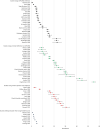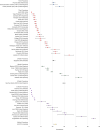A systematic review of the global prevalence and incidence of shoulder pain
- PMID: 36476476
- PMCID: PMC9730650
- DOI: 10.1186/s12891-022-05973-8
A systematic review of the global prevalence and incidence of shoulder pain
Abstract
Background and objectives: Studies reporting on the population burden of people living with shoulder pain show wide heterogeneity in terms of case definition, study samples, and occurrence. This systematic review aims to summarize evidence pertaining to the prevalence and incidence of shoulder pain, including variability based on sex and geography. We also explored the potential influence of methodological limitations and important sources of heterogeneity (case definition and reference period) on reported estimates of shoulder pain prevalence.
Databases and data treatment: The study protocol was registered on Prospero under CRD42021243140. We searched EMBASE, CINAHL, Web of Science and Medline from inception to March 2021. Study selection, data extraction and risk of bias assessment was conducted by a team of three researchers. We performed a narrative synthesis of the data, using forest plots to summarize study findings, and stratified data presentation to explore the potential association of risk of bias, case definition, and reference period with estimates of prevalence and incidence of shoulder pain.
Results: We obtained data from 61 studies reporting data from high-, middle- and low-income countries. The overall risk of bias was low, with most rated as "low-risk" and no studies rated as "high-risk". The community prevalence of shoulder pain varied widely across the countries included in our review, with a median of 16% (range 0.67 to 55.2%). Longer reference periods were typically associated with higher prevalence estimates. Primary care prevalence ranged from 1.01 to 4.84% (median 2.36%). Estimates were generally higher for women than men and were higher in high-income nations. The incidence of shoulder pain ranged from 7.7 to 62 per 1000 persons per year (median 37.8 per 1000 persons per year). Risk of bias did not clearly explain variability in study findings, but there was considerable variation in study samples, methods used, and a relative absence of data from low-income countries.
Conclusions: Our review demonstrates that a significant proportion of the population across the world will experience shoulder pain daily, yearly, and throughout a lifetime. Regional gaps in evidence and methodological inconsistencies must be addressed in order to establish a more definitive global burden.
Keywords: Epidemiology; Global health; Incidence; Prevalence; Primary care; Shoulder pain.
© 2022. The Author(s).
Conflict of interest statement
The authors declare that they have no competing interests.
Figures
References
-
- Urwin M, Symmons D, Allison T, Brammah T, Busby H, Roxby M, et al. Estimating the burden of musculoskeletal disorders in the community: the comparative prevalence of symptoms at different anatomical sites, and the relation to social deprivation. Ann Rheum Dis. 1998;57(11):649–655. doi: 10.1136/ard.57.11.649. - DOI - PMC - PubMed
-
- Bilberg R, Nørgaard B, Overgaard S, Roessler KK. Mental health and quality of life in shoulder pain patients and hip pain patients assessed by patient reported outcome. Int. J. Orthop. Trauma Nurs. 2014;18(2):81–88. doi: 10.1016/j.ijotn.2013.07.003. - DOI
Publication types
MeSH terms
LinkOut - more resources
Full Text Sources
Medical





